Balver Höhle
Cave of Balve
Useful Information
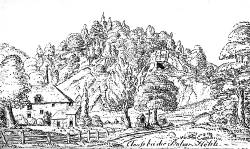
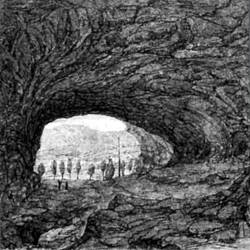
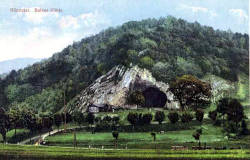
| Location: |
A45 exit Lüdenscheid, B229 26 km to Balve Werdohl, located at the road to Helle, 1 km NE Balve.
(51.3392502, 7.8718536) |
| Open: |
Only after appointment, for groups of 10 or more. [2020] |
| Fee: |
Adults EUR 1. [2020] |
| Classification: |
 Karst Cave Karst Cave
 Collapsed Cave
Oberes Devon (Massenkalk) Collapsed Cave
Oberes Devon (Massenkalk)
|
| Light: |
 Electric Light Electric Light
|
| Dimension: | L=150 m, B=18 m, H=12 m, 240 m asl GR: L=60 m, B=18 m, H=11 m. Portal: H=12 m, B=18 m. |
| Guided tours: | L=500 m, V=15,000/a [2005]. |
| Photography: | allowed |
| Accessibility: | yes |
| Bibliography: |
Klaus Günther (1964):
Die Altsteinzeitlichen Funde der Balver Höhle
Bodenaltertümer Westfalens VIII, Aschendorffsche Verlagsbuchhandlung Münster Westfalen 1964, ISBN 978-3-947450-54-1.
DOI
pdf
|
| Address: |
Verkehrsverein Balve e.V., Widukindplatz 1, 58802 Balve, Tel: +49-2375-926-190.
E-mail: Schützenbruderschaft St. Sebastian Balve e.V., Im Tenterode 1, 58802 Balve, Tel. +49-2375-1887. E-mail: |
| As far as we know this information was accurate when it was published (see years in brackets), but may have changed since then. Please check rates and details directly with the companies in question if you need more recent info. |
|
History
| 1690 | first drawn on a map |
| 1791 | first mentioned in writing. |
| 1815 | first examined and roughly measured. |
| 183? | start of mining of the cave sediment as fertiliser. |
| 1840 | creation of a shooting range in the entrance area. |
| 1843 | investigation of the cave by the Royal Mining Office of Siegen and the Mining Office of Bonn. |
| 1844 | excavations by mine director Noeggerath, Wagner and Castendyck. |
| 1869 | beginning of the shooting festivals in the cave. |
| 1870 | excavation by Rudolf Virchow in the left side passage. |
| 1871 | excavation by Heinrich von Dechen in the right side corridor. |
| 1872 | excavation by Schaafhausen. |
| 1922 | Mysterienspiele (mystery plays) in the cave by Theodor Pröpper and the Balver Heimwacht. |
| 1925 | excavation by Andree. |
| 1938 | excavation by Wehrli. |
| 1939 | excavation by Bahnschulte. |
| 1944 | relocation of an armament factory to the Balver Cave. |
| 1947 | it was to be blown up for this reason. |
| 1991 | Balver Märchenwochen (Balve Fairy Tale Weeks) founded. |
| 1997 | Festspiele Balver Höhle e.V. takes over the cave festival from the town of Balve. |
Description
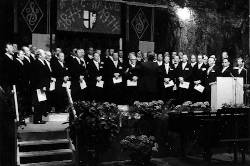
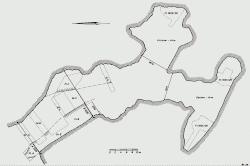
Balver Cave is a cave ruin consisting of a single large Y-shaped passage. The portal to the Hönne valley, with a height of 12 m and a width of 18 m, is one of the largest cave portals in Germany. The 54m-long main passage behind it has comparable dimensions. Historical descriptions speak of the largest mountain hall in Europe. However, this is not only old-fashioned but also outdated; many discoveries have been made since this sentence was written. But the superlative of the great portal will not change, Germany has been surveyed nationwide and all cave portals are known. At the end of the cave are two side arms, the Virchowarm, named after Prof. Dr. Rudolf Virchow and the Dechenarm, named after Bergrat von Dechen.
According to legend, the workshop of Wieland, the blacksmith from the Saga of the Nibelungs, was located in the Balver Cave. An English document reports that Wieland practised his craft in southern Westphalia. However, the Balver cave is only given in the Soest edition, probably due to a corresponding local legend.
This cave was a regular shelter for hunter-gatherers during the Palaeolithic and is therefore also referred to as a cultural cave. This and many other terms still used in connection with the cave today date from the 19th century. It was archaeologically explored at that time and many publications still cite the work of that time, although many of them are outdated both in terms of language and conclusions. Unfortunately, the cave in its present state has been completely cleared out, so archaeological research is no longer possible. It is believed that it was originally filled to a height of 9 m with sediment, almost 80% of the present cavity. A lithograph by Friedrich C.D. von und zu Brenken from 1826 shows that the cave was almost completely filled in at the entrance. It was not until the 1830s that the citizens of Balve began to mine the phosphate-rich clay as fertiliser. Hundreds of stone tools were simply thrown onto the embankment in front of the cave or used with the clay to fertilise the fields. In later times, it was quite productive to search for artefacts in the surrounding fields.
From undisturbed layers, some 700 implements and a myriad of tees and waste pieces were later recovered. Remains of cave bear, mammoth, horse, giant deer and others were also found. The most beautiful find is probably a 4.60 m long mammoth tusk, a replica of which can be seen today in the Arnsberg Museum of Local History. With a total of more than 53,000 artefacts, Balver Cave is one of the most important sites of the Palaeolithic in Central Europe. The debris masses continuously created by frost blasting on the ceiling preserved the settlement remains of hundreds of thousands of years. The layers were numbered from bottom to top with Roman numerals. A distinction is made between Balve I (Late Acheulian, 100,000 years), Balve II, III and lVa (Micoquian, 75,000 years) and Balve IVb (Late Moustérian, 40,000 years). Today, the finds can be seen in the Westphalian Museum of Archaeology in Herne and in the Museum of Prehistory and Early History in Werdringen moated castle in Hagen.
The archaeological investigations began with the legendary exploration of the cave by the Royal Mining Office of Siegen and the Mining Office of Bonn in 1843. They ended in 1939 with the Second World War. The destruction of the strata was also contributed to by looting, with dozens of scientists and amateur researchers digging for knowledge and marketable finds. Even the scientists often only evaluated the parts that were important for their research and disposed of everything else as rubble. In 1944, an armament factory was relocated to the cave and for this purpose probably the last sediment remains were removed and the ground levelled. It was a supplier to the Gothaer Waggonfabrik, which built aircraft. Moreover, this military use almost led to the cave being blown up by the Allies in 1947. This probably failed in the first place because the cave is much too big.
The cave has been used as a venue since 1922. At that time, the Mysterienspiele (mystery plays) were performed in the cave, organised by Theodor Pröpper and the Balver Heimwacht. Many citizens of the town took part as amateur actors. Theodor Pröpper was a composer, church musician and local poet. After a few years, however, the plays fell asleep again.
After the Second World War, Theodor Pröpper and Hermann Wedekind established the Balver Höhlenspiele. They were held from 1947 to 1958, and after a break of 25 years revived by Hermann Wedekind in 1984. With the founding of the association Festspiele Balver Höhle e.V. in 1985, the plays finally became a permanent cultural institution. Since 1991, the Balver Märchenwochen, a theater with fairy tales for children, have been held. In addition, the Night of Music, the Italian Night, the Irish Folk & Celtic Music Festival, the German Kultrock Festival and various other concerts take place annually. Videos of various events can be found in abundance on youTube.
The cave is owned by the municipality of Balve, the Schützenbruderschaft St. Sebastian Balve is the tenant of the cave. Both the cave and the Schützenheim next door are rented out to event organisers on a daily basis. The shooting club uses the cave for the shooting festival held on the 3rd weekend in July. Visits to the cave are only possible for groups after booking with the tourist office. Of course, only when there is no event going on. But of course you can always visit a concert or a theatre performance.
- See also
 Search DuckDuckGo for "Balver Höhle"
Search DuckDuckGo for "Balver Höhle" Google Earth Placemark
Google Earth Placemark OpenStreetMap
OpenStreetMap Balve Cave - Wikipedia (visited: 18-DEC-2020)
Balve Cave - Wikipedia (visited: 18-DEC-2020) Festspiele Balver Höhle e.V.
Festspiele Balver Höhle e.V.  (visited: 18-DEC-2020)
(visited: 18-DEC-2020) Balver Höhle
Balver Höhle  (visited: 18-DEC-2020)
(visited: 18-DEC-2020) Kultur in der Balver Höhle - Naturhistorischer Verein Hönnetal e.V.
Kultur in der Balver Höhle - Naturhistorischer Verein Hönnetal e.V.  (visited: 18-DEC-2020)
(visited: 18-DEC-2020) Die Balver Höhle
Die Balver Höhle  (visited: 19-DEC-2020)
(visited: 19-DEC-2020)
 Index
Index Topics
Topics Hierarchical
Hierarchical Countries
Countries Maps
Maps